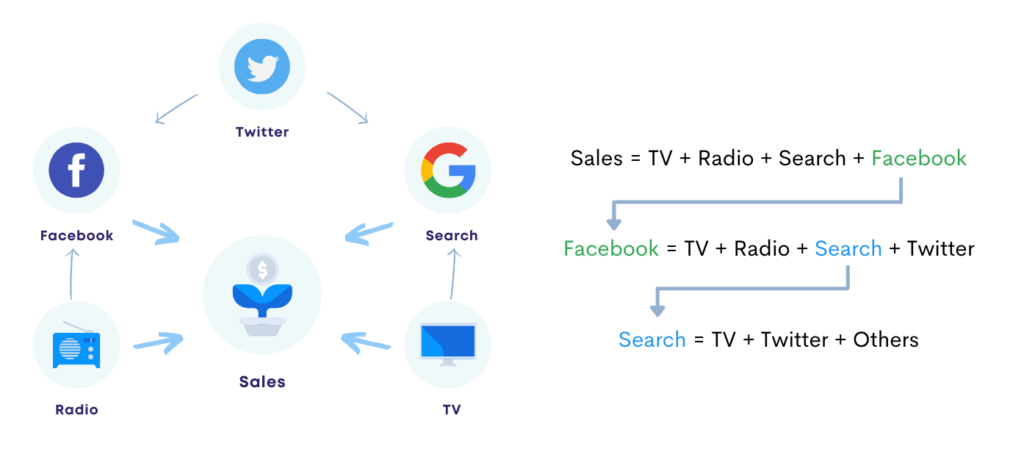Marketing is a dynamic field. Consumers’ interactions with brands and responses to marketing activities are constantly evolving through paid, owned, and earned media. Furthermore, the amount of data produced and the number of KPIs associated with marketing and communication are proliferating as time passes. In this constantly evolving and dynamic setting, measurement becomes more complicated and that is where Nested Modeling comes into play.
What are Nested Models?
A Nested Model depicts an immersive relationship between multiple linked KPIs and independent drivers. Two models are nested if one model contains all the variables of the other in addition to (an) other variable (s).
A typical example largely encountered in Marketing Mix Modeling is TV advertisement and paid Search. In fact, it is largely expected that:
• TV advertisement impacts sales directly, i.e., consumers buy the brand following the exposure to TV advertisement – with some delay modeled through carryover/Ad Stock.
• TV advertisement impacts search as some consumers exposed to the TV commercial will search for the brand ahead of buying.
In this case, we cannot have search and TV as independent variables in the same equation without considering an intermediary step as Search is not independent from TV. Technically this is called an endogeneity problem.
To measure the above setting, we use Nested Models where the Sales model is considered as the complete (or full) model, and the Search model is the smaller or the reduced/restricted model.
Nested Modeling goes beyond the example described above and could cater for more complex situations allowing multilevel nesting as illustrated in the figure below:

Advantages of Using Nested Modeling
Nested Modeling allows to measure the direct and indirect impact of each sales driver, which is very useful especially when reporting on offline and online channels’ interaction, where multiple touchpoints are used.
Nesting brand indicators such as awareness, consideration, and other brand-related metrics in the main sales equation (the full/complete model) allows to measure for example the so sought-after brand impact.
Benefits of Nested Models include:
• Quantifying the true relationship between Paid, Owned, and Earned Media.
• Adjusting sales contribution by considering the indirect impact.
• Providing more accurate interpretations by calculating the influence of omitted variables.
• Gaining a complete view of the brand’s ROI.
• Adjusting ROI measurement and optimization based on a thorough analysis of all touchpoints.
Challenges of Using Nested Modeling
Nested Modeling is a powerful technique to disentangle the direct and indirect impact of different sales drivers. However, this technique brings its own list of challenges. For starters, modeling the interactivity of different media variables in a sophisticated contemporary landscape is a resource-heavy process.
The full scale of complexity of Nested Modeling is multiple levels of magnitude compared to classic modeling. Introducing multilevel modeling to marketing measurement means the creation of a significant difficulty due to the sheer number of indirect impacts to be calculated. If this measurement is conducted across different product lines, the process gets even more complicated.
Due to the complexity and scale of calculations needed in applying the Nested Modeling methodology, a new set of skills and approaches is needed to tackle it. It is simply not a viable solution to use manual calculations to implement it.
Specialized Marketing Mix Modeling tools are essential to this. as they introduce a degree of automation that can turn this technique from a heavy investment into an achievable endeavor. Powerful solutions can automate a large portion of the data preparation and data processing phases, which are known to take long in traditional Marketing Mix Modeling projects. Additionally, Machine Learning algorithms can be leveraged to streamline modeling and ensure that the modeler’s time is spent on calibrating and extracting insights from the model instead of processing the data or going through the heavy calculation that the nested models entail.
MASS Analytics Method
The Nested Model approach implemented in MassTer, MASS Analytics’ end-to-end modeling platform, is an improvement over the currently used approach by the industry and is believed to offer more accurate results with more sound economical interpretations, more specifically:
- No limitation in the number of models to be nested (i.e. the reduced models) which allows to better model complex real-life touchpoints.
- An automated attribution screen specifying the direct and indirect impact of each variable.
- ROI and Optimization calculations are adjusted to account for the indirect impact leading to more accurate results.
- It preserves the stationarity assumption of the underlying OLS method by providing constant time-independent coefficients.
- It allows the quality of the Nested Model to affect the resulting final model, hence preserving an accurate overall picture.
- Assigns part of the base component of the Nested Model to the base of the main model
- The reduced model variable still shows in the main model.
- Variations of the Nested Model could be easily used ( e.g. lagged, decayed…) allowing for example to capture brand effect.
MASS Analytics promotes a contemporary Marketing Mix Modeling approach delivering faster, automated, and dynamic models powered by Machine Learning to accurately measure the impact of media and marketing in a complex and interactive media landscape.
To find out how our experts and tools can help you optimize your marketing ROI using the Nested Modeling technique, book a demo with us here.






